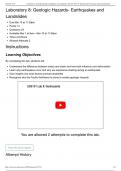2024/3/6 18:40 Laboratory 8: Geologic Hazards- Earthquakes and Landslides: ESS 101 B Wi 24: Introduction To Geology And Societal Impacts
Laboratory 8: Geologic Hazards- Earthquakes and
Landslides
Due Mar 10 at 11:59pm
Points 14
Questions 24
Available Mar 1 at 9am - Mar 10 at 11:59pm
Time Limit None
Allowed Attempts 2
Instructions
Learning Objectives
By completing this lab, students will:
Understand the difference between stress and strain and how both influence rock deformation
Learn why earthquakes occur and why we experience shaking during an earthquake
Gain insights into what factors promote landslides
Recognize why the Pacific Northwest is prone to certain geologic hazards
ESS101 Lab 8: Geohazards
You are allowed 2 attempts to complete this lab.
Take the Quiz Again
Attempt History
https://canvas.uw.edu/courses/1699809/quizzes/1953711 1/32
,2024/3/6 18:40 Laboratory 8: Geologic Hazards- Earthquakes and Landslides: ESS 101 B Wi 24: Introduction To Geology And Societal Impacts
Attempt Time Score
LATEST Attempt 1 26 minutes 14 out of 14
Answers will be shown after your last attempt
Score for this attempt: 14 out of 14
Submitted Mar 6 at 6:40pm
This attempt took 26 minutes.
Introduction
Most of the geological processes that we have covered in previous labs take place over thousands or
millions of years. Many of these processes are impossible to observe during our lifetimes and have
little direct effects on our everyday lives. In this lab, we are going to focus on geologic processes that
can occur almost instantaneously and that profoundly impact our lives and the landscapes we live in.
In particular, we will explore the processes that produce earthquakes and landslides, two phenomena
that pose serious geologic hazards in the Pacific Northwest.
Question 1
pts
Laboratory Honor Statement
Cheating or plagiarism of any kind will not be tolerated in ESS 101. This includes copying answers
from a friend or classmate, copying answers verbatim found on the internet or other literary sources,
or copying any work that may answer the question being asked. Make sure you always use your own
words when answering the questions in the homework and cite appropriate references if you use
them to help you answer the question. Anyone caught violating the academic code of conduct
(https://www.washington.edu/cssc/for-students/academic-misconduct/) will receive a “0” grade on the
assignment, and if the conduct is deemed egregious, reported to the UW Academic Misconduct
representative.
I acknowledge that I have carefully read and understand the above statement regarding the
consequences of cheating and plagiarism, and promise to complete my work in this class with
honesty and integrity. Answer "True" below supporting your acknowledgement.
True
False
A. Earthquakes and Faults
https://canvas.uw.edu/courses/1699809/quizzes/1953711 2/32
,2024/3/6 18:40 Laboratory 8: Geologic Hazards- Earthquakes and Landslides: ESS 101 B Wi 24: Introduction To Geology And Societal Impacts
Stress and Strain
As you learned in Lab 2, the Earth’s crust is broken up into tectonic plates. The movements of these
plates exerts great forces, termed stresses, at their boundaries. Importantly, not all stress is the
same. The specific type of stress produced from the motion of a given plate depends directly on the
type of plate boundary. For example, a divergent boundary will produce a different stresses than a
convergent boundary. In addition, stress can be placed on rocks within a plate (rather than at a
boundary) from a variety of sources, such as a glacier pushing down (compressing) a section of a
plate. Generally, we can divide stress into three categories: tension, compression, and shear.
Figure 8-1 below illustrates each of these:
Figure 8-1 Diagrams illustrating the three different types of stress. Source:
https://earthquake.usgs.gov/learn/glossary/?term=compressional%20stress
(https://earthquake.usgs.gov/learn/glossary/?term=compressional%20stress)
As you can see Figure 8-1, each type of stress represents a different force. As you can see in the
figure, each type of stress represents a different force. Tensional stress is equivalent to forces pulling
rocks apart, while compressional stress is equivalent to forces pushing rocks together. Shear stress is
different from each of these, as it forces rocks to slide past one another.
Question 2
0..25 pts
Look at the outcrop picture below. Which type of stress do you think produced the structure in these
rocks?
https://canvas.uw.edu/courses/1699809/quizzes/1953711 3/32
, 2024/3/6 18:40 Laboratory 8: Geologic Hazards- Earthquakes and Landslides: ESS 101 B Wi 24: Introduction To Geology And Societal Impacts
Source: http://www.geologyin.com/2015/02/rock-deformation-causes-and-types.html (http://www.geologyin.com/2015/02/rock-deformation-
causes-and-types.html)
compression
tension
shear
The manner in which a rock deforms in response to stress is called strain. Just as there are multiple
types of stress, there are different categories of strain. The type of strain experienced by a rock
depends on a number of variables, including the composition of the rock, how long it is under stress,
the rate at which it is stressed, and the temperature and pressure at which it is stressed. Generally,
we can divide strain into three groups: elastic, plastic, and brittle.
Moving from elastic to plastic to brittle, the change in the shape of the rock becomes more extreme.
Elastic strain will produce a temporary change in the rock structure, where the rock returns to its
original shape after the stress is removed. Plastic strain will produce permanent changes in the rock’s
structure without breaking the rock, such as folds. Brittle strain will also produce permanent changes,
but will do so by fracturing and breaking the rock.
Question 3
0..25 pts
During the last ice age (about 12,000 years ago), much of North America was covered by glaciers.
Today, we can still observe the strain that those glaciers imparted on the rocks below them. The
figure below illustrates this, showing the vertical velocities of the crust in North America, increasing
from blue to red. What type of strain do you think the glaciers caused?
https://canvas.uw.edu/courses/1699809/quizzes/1953711 4/32




